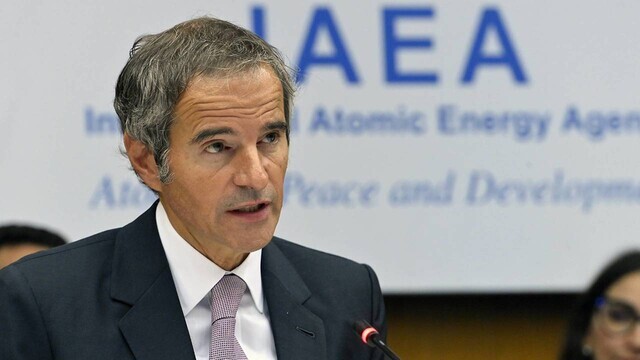hankyoreh
Links to other country sites 다른 나라 사이트 링크
N. Korea continues to prepare for nuclear test, says IAEA chief

The International Atomic Energy Agency (IAEA) revealed that North Korea is preparing for an additional nuclear test at its nuclear testing site in Punggye Village, Kilju County, North Hamgyong Province. The nuclear facility at Yongbyon, North Pyongan Province, also showed signs of an activated nuclear reactor as well as an expanded uranium enrichment facility.
During his opening address for the IAEA’s board of governors meeting held in Vienna, Austria, on Monday, the agency’s director general, Rafael Grossi, stated, “As I reported in June, we have observed indications that Adit 3 at the Nuclear Test Site at Punggye-ri has been reopened,” adding that the agency had “very recently observed renewed work on the road leading to Adit 4.”
Though extensive work on the testing site was not observed over the summer, the agency continues to “observe indications that the site remains active and prepared to support a nuclear test,” Rossi said.
“The conduct of a nuclear test would contravene UN Security Council resolutions and would be a cause of serious concern,” he added.
“There are ongoing indications that the 5MW(e) reactor is operating and we have observed indications of intermittent activity at the Radiochemical Laboratory consistent with possible waste treatment or maintenance activities,” Grossi went on.
“We have observed indications that the reported Centrifuge Enrichment facility at Yongbyon continues to operate and is now externally complete, expanding the building’s available floor space by approximately one-third.”
He also noted that the agency had “observed the completion of several new buildings near the light water reactor.”
“At the 50MW(e) reactor, construction of which stopped in 1994,” he said, “we have observed the dismantling of buildings and the removal of some material, likely for re-use in other construction projects.”
Additionally, “ongoing indications of activities at the Kangsan complex and the Pyongsan Mine and Concentration Plant” were observed, Grossi said.
By Jung In-hwan, staff reporter
Please direct questions or comments to [english@hani.co.kr]

Editorial・opinion
![[Editorial] Intensifying US-China rivalry means Seoul must address uncertainty with Beijing sooner than later [Editorial] Intensifying US-China rivalry means Seoul must address uncertainty with Beijing sooner than later](https://flexible.img.hani.co.kr/flexible/normal/500/300/imgdb/original/2024/0517/8117159322045222.jpg) [Editorial] Intensifying US-China rivalry means Seoul must address uncertainty with Beijing sooner than later
[Editorial] Intensifying US-China rivalry means Seoul must address uncertainty with Beijing sooner than later![[Column] When ‘fairness’ means hate and violence [Column] When ‘fairness’ means hate and violence](https://flexible.img.hani.co.kr/flexible/normal/500/300/imgdb/original/2024/0516/7417158465908824.jpg) [Column] When ‘fairness’ means hate and violence
[Column] When ‘fairness’ means hate and violence- [Editorial] Yoon must stop abusing authority to shield himself from investigation
- [Column] US troop withdrawal from Korea could be the Acheson Line all over
- [Column] How to win back readers who’ve turned to YouTube for news
- [Column] Welcome to the president’s pity party
- [Editorial] Korea must respond firmly to Japan’s attempt to usurp Line
- [Editorial] Transfers of prosecutors investigating Korea’s first lady send chilling message
- [Column] Will Seoul’s ties with Moscow really recover on their own?
- [Column] Samsung’s ‘lost decade’ and Lee Jae-yong’s mismatched chopsticks
Most viewed articles
- 1[Editorial] Transfers of prosecutors investigating Korea’s first lady send chilling message
- 2[Exclusive] Unearthed memo suggests Gwangju Uprising missing may have been cremated
- 3[Column] US troop withdrawal from Korea could be the Acheson Line all over
- 4Xi, Putin ‘oppose acts of military intimidation’ against N. Korea by US in joint statement
- 5[Column] When ‘fairness’ means hate and violence
- 6[Editorial] Intensifying US-China rivalry means Seoul must address uncertainty with Beijing sooner t
- 7‘Shot, stabbed, piled on a truck’: Mystery of missing dead at Gwangju Prison
- 8Spotlight turns to Hyundai Group Chairwoman’s visit to North Korea
- 9[Column] Samsung’s ‘lost decade’ and Lee Jae-yong’s mismatched chopsticks
- 10[Column] Will Seoul’s ties with Moscow really recover on their own?